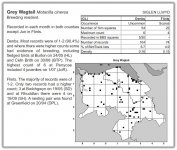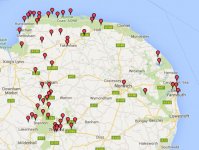I sense a heated debate coming up........
I won't share my opinion here at the moment, but am I right in saying that the majority of UK county bird reports source material from Birdtrack?
Cheers,
Jim.
Jim
Sorry to disappoint but there is no debate to be had here either heated or otherwise. The main reason that BirdTrack is not used by the county as the primary source of bird records for NBMR is, to put it bluntly, the data it produces is wholly unsuited for the production of a county report.
Let me immediately make it crystal clear that this is not the fault of BirdTrack since it was never designed to be used for that purpose. What it was designed for (among other things) was to gather bird records in bulk (I believe that it holds literally millions of records) and using software to ‘crunch the numbers’ to provide stats relating to, for example, population densities and distribution etc.
From the county recording viewpoint there are a number of issues with BirdTrack but the main one is the sheer volume of records held for individual species. While it is a case of the ‘more the merrier’ when applied to BirdTrack’s original remit, from the perspective of producing a county report it is exactly the opposite. Apologies in advance for the length of this note but I believe that the queries raised around the non-use of BirdTrack for the NBMR merits a detailed explanation.
It is worth noting that the decision to move from the existing recording system to BirdTrack was taken unilaterally without any form of consultation with the existing NBMR team. As someone who has had some experience of such changes (and what can go wrong) in the ‘real world’ I did some work on assessing what the implications might be of such a change. As a result, I was able to compare like-for-like outputs from both BirdTrack and our existing recording system for Blackbird and Red-breasted Flycatcher in respect of 2013.
While there were a number of issues with the BirdTrack RB Fly records including incomplete data, wrong location and duplicates the most striking problem was the number of records of Blackbird. Rather than bore you all with statistics, I have attached 2 files to this post.
Firstly there is the output of Blackbird records from Wildlife Recorder (the county’s recording system) which holds just 94 records. This relatively modest total is as a result of observers having ‘filtered’ their records to include only the most significant ones and a second ‘filtering’ by the inputters. Based on just these records the write up for the 2013 NBMR (bearing in mind space constraints within the systematic list) shows a mix of winter counts, return movement, (limited) breeding data and autumn arrival details.
Secondly there is the BirdTrack extract for the same year. Take a look. It holds nearly 6000 records. For one species. Note that I have removed any personal data to ensure of not falling foul of any Data Protection issues.Also I had to delete substantial amounts of data just to reduce it in size to get it into Birdforum!
I am reasonably proficient around data handling and using Excel and given enough time I am sure I could have edited it down to something more manageable. But why should I? And why should I have had to do the same for Song Thrush, Fieldfare, Redwing etc etc.
To give you some perspective around the volumes we are talking about, for ‘my’ species (Thrushes, Flycatchers, Shrikes and Crests), normally about 2000 records cover all of them. If you take a look at previous NBMRs you will see that from this total, each species has a reasonable write up given space constraints within the report.
The BirdTrack extracts for ‘my’ species for 2014 was >13,000 – totally unrealistic and unmanageable (and I say that as someone who is retired and has time spend to sort it out).
Everyone involved with the NBMR is a volunteer and are passionate about what they do but most have jobs and families (as well as being keen birders) and are not ‘experts’ at dealing with huge volumes of data. When the BirdTrack extracts for 2014 appeared in their ‘in tray’ most were not only stunned at the volume of records but were totally overwhelmed with many of them just saying ‘no way’ and sending the records back.
At this stage it became clear that bird recording in the county was peering over the edge of a precipice with the future of the NBMR in serious doubt. I think that most are aware of the changes that took place subsequently and thanks to the efforts of many (especially the observers who were prepared to resubmit their records for inclusion in the 2014 county database) the NBMR for 2014 appeared just a few weeks later than normal.
I am hoping that any reasonable person will now understand why the county has reverted to using their ‘own’ data and systems rather than BirdTrack.
I think it is worth saying that while BirdTrack does not provide direct input to our records, we do have a good two-way relationship with the BTO. For example, I believe that our RBBP reporting process is as good as any other county and we are also fortunate to have access to the Breeding Bird Survey data which we have begun to incorporate into the NMBR.
Finally, a plea to those birders who do use BirdTrack. Yes it is slightly inconvenient to have to submit your sightings twice but my (limited!) understanding is that it is quick and easy for you to extract the details as a single file which can then be sent to the County Recorder(s) as outlined in my original note.
Many thanks if you’ve managed to get this far!
Regards
Mick
PS: Jim - I am sure that BTO can supply you with a list of counties who use BirdTrack as the sole source of records for their annual reports.






